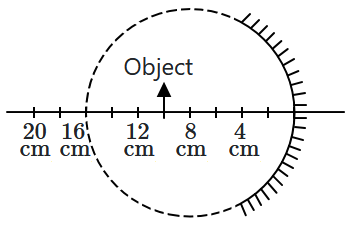1. \(60~\text{cm}\)
2. \(24~\text{cm}\)
3. \(30~\text{cm}\)
4. \(-24~\text{cm}\)

1. \({3f}\)
2. \({3\over 2}{f}\)
3. \({f}\)
4. \({2f}\)

Identify the correct statements.
| A. | The image executes periodic motion |
| B. | The image executes non-periodic motion |
| C. | The turning points of the image are asymmetric w.r.t. the image of the point at \(x = 10~ \text{cm}.\) |
| D. | The distance between the turning points of the oscillation of the image is \(\frac{100} {21} ~\text{cm}.\) |
1. (B) and (C) only
2. (A), (C), and (D) only
3. (A) and (D) only
4. (B) and (D) only
A concave mirror for face viewing has focal length of \(0.4~\text{m}\). The distance at which you hold the mirror from your face in order to see your image upright with a magnification of \(5\) is:
1. \(1.60~\text{m}\)
2. \(0.16~\text{m}\)
3. \(0.32~\text{m}\)
4. \(0.24~\text{m}\)
A concave mirror has a radius of curvature of \(40~\text{cm}\). It is at the bottom of a glass that has water filled up to \(5~\text{cm}\) (see figure). If a small particle is floating on the surface of the water, its image as seen, from directly above the glass, is at a distance \(d\) from the surface of the water. The value of \(d\) is close to: ( Refractive index of water \(1.33\))
1. \(11.7~\text{cm}\)
2. \(6.7~\text{cm}\)
3. \(13.4~\text{cm}\)
4. \(8.8~\text{cm}\)
A spherical mirror is obtained as shown in the figure from a hollow glass sphere. If an object is positioned in front of the mirror, what will be the nature and magnification of the image of the object? (Figure drawn as schematic and not to scale)

| 1. | Inverted, real and magnified |
| 2. | Erect, virtual and magnified |
| 3. | Erect, virtual and unmagnified |
| 4. | Inverted, real and unmagnified |
When an object is kept at a distance of \(30~\text{cm}\) from a concave mirror, the image is formed at a distance of \(10~\text{cm}\) from the mirror. If the object is moved with a speed of \(9~\text{cms}^{-1}\), the speed (\(\text{in cms}^{-1}\)) with which image moves at that instant is:
1. \(4\)
2. \(3\)
3. \(2\)
4. \(1\)
1. \(f=+\dfrac{1}{2}r\)
2. \(f=-r\)
3. \(f=-\dfrac{1}{2}r\)
4. \(f=r\)
A short straight object of height \(100\) cm lies before the central axis of a spherical mirror whose focal length has an absolute value \(|f|=40~\text{cm}\). The image of the object produced by the mirror is of height \(25\) cm and has the same orientation as the object. One may conclude from the information:
| 1. | The image is real, on the same side of the concave mirror. |
| 2. | The image is virtual, on the opposite side of the concave mirror. |
| 3. | The image is real, on the same side of the convex mirror. |
| 4. | The image is virtual, on the opposite side of the convex mirror. |
1. \(15~\text{cm}\)
2. \(25~\text{cm}\)
3. \(35~\text{cm}\)
4. \(30~\text{cm}\)







